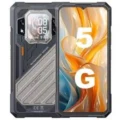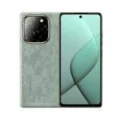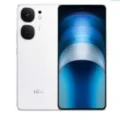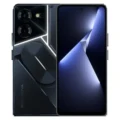Nokia 7 plus






- : 4/6GB RAM Snapdragon 660
- : 6.0" 1080x2160 pixels
- : 3800mAh 18W
- : 13MP 2160p
Introducing the Nokia 7 Plus – a powerful and stylish smartphone that redefines your mobile experience. With a perfect blend of cutting-edge features and premium design, the Nokia 7 Plus stands out as a reliable and sophisticated device.
Immerse yourself in a cinematic viewing experience with the Nokia 7 Plus’s 6-inch Full HD+ display. The edge-to-edge screen provides stunning visuals, making it perfect for streaming, gaming, and browsing. The phone’s sleek aluminum unibody not only exudes elegance but also ensures durability, making a statement both in style and substance.
Equipped with a Qualcomm Snapdragon 660 processor and 4GB of RAM, the Nokia 7 delivers seamless multitasking and responsive performance. The 64GB of internal storage, expandable up to 256GB via microSD, provides ample space for your apps, photos, and media.
Capture exceptional moments with the dual rear Zeiss cameras – a 12MP main sensor and a 13MP telephoto lens. The Pro Camera mode allows you to take control of your photography settings, while the 16MP front-facing camera ensures your selfies are always Instagram-worthy.
Running on the Android One platform, the Nokia 7 Plus guarantees a pure and secure Android experience. Stay up-to-date with the latest features and security patches, free from unnecessary bloatware. Enjoy easy access to a world of apps on the Google Play Store.
Keep powered throughout the day with the Nokia 7 Plus’s 3800mAh battery and fast-charging capabilities. The phone’s efficient energy management ensures that you stay connected and productive without interruptions.
Elevate your mobile experience with the Nokia 7 Plus – a smartphone that combines style, performance, and reliability. Upgrade to a device that exceeds expectations in every aspect.
Specs
Network
| 2G Network GSM 850 / 900 / 1800 / 1900 - SIM 1 & SIM 2 (dual-SIM) CDMA 800 / 1900 |
GSM 850 / 900 / 1800 / 1900 - SIM 1 & SIM 2 CDMA 800 & TD-SCDMA - China |
| 3G Network |
HSDPA 850 / 900 / 1900 / 2100 CDMA2000 1xEV-DO - China |
| 4G Network |
1, 3, 5, 7, 8, 20, 28, 38, 40, 41 - Global 1, 3, 4, 5, 7, 8, 20, 28, 34, 38, 39, 40, 41 - China |
| Speed |
HSPA 42.2/5.76 Mbps, LTE-A (2CA) Cat6 300/50 Mbps |
LAUNCH
| Announced | February, 2025 |
| Status |
Available. Released 2018, April 30 |
BODY
| Dimensions | 158.4 x 75.6 x 8 mm (6.24 x 2.98 x 0.31 in) |
| Weight | 183 g (6.46 oz) |
| Build | Glass front (Gorilla Glass 3), aluminum back, aluminum frame (6000 series) |
| SIMs SIM (Subscriber Identity Module) is a small card that contains mobile network subscriber's account information. This allows the phone using the card to attach to a mobile network. The SIM card is most commonly associated with GSM and UMTS mobile networks. Moving a SIM card from one phone to another allows a subscriber to switch mobile phones without having to contact their mobile network carrier. SIM cards can also be used by a phone to store limited amounts of data, such as phone numbers and text messages. |
Hybrid Dual SIM (Nano-SIM, dual stand-by) |
Display
| Display Type Display Technology => A number of display technologies and types used in mobile phones => TFT (Thin Film Transistor), IPS (In-Place Switching), OLED (Organic Light Emitting Diode), AMOLED (Active-Matrix Organic Light-Emitting Diode), Super AMOLED (an even advanced version of AMOLED), Resistive Touchscreen (Resistive touchscreens contain two layer of conductive material with a very small gap between them which acts as a resistance), Capacitive Touchsceen (Capacitive touchscreen technology consists of a layer of glass coated with a transparent conductor) | IPS LCD |
| Size | 6.0 inches, 92.4 cm2 (~77.2% screen-to-body ratio) |
| Resolution | 1080 x 2160 pixels, 18:9 ratio (~403 ppi density) |
| Protection Display Protection => Gorilla Glass is a special alkali-aluminosilicate glass shield with exceptional damage resistance that helps protect mobile displays from scratches, drops, and bumps of everyday use, It is always better to go for a smartphone with Gorilla Glass for that added protection and peace of mind. | Corning Gorilla Glass 3 |
PLATFORM
| Operating System OS => Every computer system run on a base software called Operating System (OS). Operating System controls all basic operations of the computer (such as smartphone, PDAs, tablet computers and other handheld devices). The Operating System allows the user to install and run third party applications (apps), apps are used to add new functionality to the device. | Android 8.1 (Oreo), upgradable to Android 10, Android One |
| Chipset Chipset is a group of integrated circuits designed to perform one or a more dedicated functions, often with real time computing constraints, Popular smartphones are equipped with more advanced embedded chipsets that can do many different tasks depending on their programming. | Qualcomm SDM660 Snapdragon 660 (14 nm) |
| CPU CPU (Central Processing Unit) mostly known as processors, CPU processes instructions in order to carry out certain functions that make your device operate properly. Processors are often described as the brain of computers, smartphones and tablets, Smartphones and tablets rely on processors to carry out their every task, Processors are an incredibly important factor in selecting any type of computing device, including your smartphone. | Octa-core (4x2.2 GHz Kryo 260 Gold & 4x1.8 GHz Kryo 260 Silver) |
| GPU GPU (Graphics Processing Unit) is a single-chip processor designed to rapidly manipulate and alter memory to accelerate the creation of images in a frame buffer intended for output to a display, This includes things such as lighting effects, object transformations, and 3D motion. | Adreno 512 |
MEMORY
| Card Slot Memory Card Slot is a special slot for inserting a memory card. Memory cards allow you to expand the phone's built-in memory, A memory card (sometimes called a flash memory card or a storage card) is a small storage medium used to store data such as text, pictures, audio, and video, for use on small, portable or remote computing devices such as mobile phones, mp3 players, digital cameras. | microSDXC (uses shared SIM slot) |
| Internal | 64GB 4GB RAM, 64GB 6GB RAM eMMC 5.1 |
MAIN CAMERA
| Cameras Specs Today’s smartphones come equipped with a very comprehensive set of camera related specifications. Our smartphone, for many of us, has become our primary camera due to it being the one we always have with us. |
12 MP, f/1.8, 25mm (wide), 1/2.55", 1.4µm, dual pixel PDAF 13 MP, f/2.6, (telephoto), 1/3.4", 1.0µm, AF, 2x optical zoom |
| Video | 4K@30fps, 1080p@30fps (gyro-EIS) |
| Camera Features |
Zeiss optics, dual-LED dual-tone flash, panorama, HDR |
SELFIE CAMERA
| Cameras Specs Today’s smartphones come equipped with a very comprehensive set of camera related specifications. Our smartphone, for many of us, has become our primary camera due to it being the one we always have with us. |
16 MP, f/2.0, 1/3.06", 1.0µm |
| Features |
Zeiss optics |
| Video | 1080p@30fps |
SOUND
| Loudspeaker | Yes |
| 3.5mm jack |
Yes |
COMMS
| WLAN |
Wi-Fi 802.11 a/b/g/n/ac, dual-band, Wi-Fi Direct |
| Positioning |
GPS, GLONASS, BDS |
| Bluetooth Bluetooth is a wireless communications technology for exchanging data between mobile phones, headsets, computers and other network devices over short distances without wires, Bluetooth technology was primarily designed to support simple wireless networking of personal consumer devices. | 5.0, A2DP, LE |
| Infrared Infrared connectivity is an old wireless technology used to connect two electronic devices. It uses a beam of infrared light to transmit information and so requires direct line of sight and operates only at close range. | |
| USB | USB Type-C 2.0, OTG |
| NFC NFC (Near field communication) is a set of standards for smartphones and similar devices to establish peer-to-peer radio communications with each other by touching them together or bringing them into proximity, usually no more than a few inches. | |
| Radio |
Features
| Sensors Sensors are electronic components that detects and responds to some type of input from the physical environment. The specific input could be light, heat, motion, moisture, pressure and location, The output is generally a signal that is converted to use in computing systems, a location sensor, such as a GPS receiver is able to detect current location of your electronic device. |
Fingerprint (rear-mounted), accelerometer, gyro, proximity, compass |
BATTERY
| Battery Type Battery Type => Cell phones run on various kinds of batteries depending on the manufacturer, phone size or shape and features. There are basically four types of cell phone batteries => Lithium Polymer, Lithium Ion, Nickel Metal Hydride and Nickel Cadmium. | Li-Ion (Lithium Ion) |
| Capacity Battery Capacity is a measure (typically in Amp-hr) of the charge stored by the battery, and is determined by the mass of active material contained in the battery. The battery capacity represents the maximum amount of energy that can be extracted from the battery under certain conditions. | 3800 mAh |
| Placement | non-removable |
MISC
| Colors |
Black/Copper, White/Copper |
| Model | TA-1041, TA-1062, TA-1046 |
| SAR EU Each GSM handset has a radio transmitter and receiver in order to operate in the wireless GSM network. That transceiver is manufactured so that when used next to the ear and when worn on the belt, it won't exceed the limits for exposure to radio frequency energy set by the authorities.The authorities in question here are the Federal Communications Commission (FCC) of the U.S. Government, Industry Canada of the Canadian Government (IC), and the Council of the European Union. |
0.36 W/kg (head) 1.78 W/kg (body) |
| Price |
About 490 EUR |
TESTS
| Performance |
AnTuTu: 140820 (v7) GeekBench: 5893 (v4.4) GFXBench: 8.6fps (ES 3.1 onscreen) |
| Display | Contrast ratio: 1701:1 (nominal), 3.479 (sunlight) |
| Loudspeaker | Voice 67dB / Noise 71dB / Ring 79dB |
| Battery (old) | Endurance rating 87h |
Reviews
Disclaimer Note
We strive to maintain accurate and up-to-date content on our website for general information purposes only. Please refrain from using the material for business, legal, or any other decisions.



















